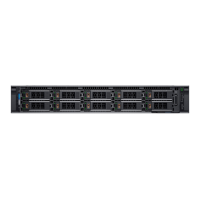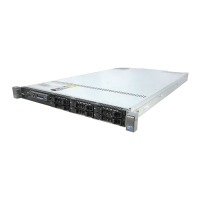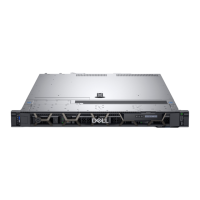Table 61. System Profile Settings details
Option Description
System Profile Sets the system profile. If you set the System Profile option to a mode other than
Performance Per Watt (DAPC), the BIOS automatically sets the rest of the options. You
can only change the rest of the options if the mode is set to Custom. This option is set to
Performance Per Watt (DAPC) by default. Other options include Custom, Performance,
Performance Per Watt (OS) and Workstation Performnce.
NOTE: All the parameters on the system profile setting screen are available only when
the System Profile option is set to Custom.
CPU Power Management Sets the CPU power management. This option is set to System DBPM (DAPC) by default.
Other option includes Maximum Performance, OS DBPM.
Memory Frequency Sets the speed of the system memory. You can select Maximum Performance, Maximum
Reliability or a specific speed. This option is set to Maximum Performance by default.
Turbo Boost Enables or disables the processor to operate in the turbo boost mode. This option is set to
Enabled by default.
Enery Efficient Turbo Energy Efficient Turbo (EET) is a mode of operation where a processor's core frequency is
adjusted within the turbo range based on workload. This option is set to Enabled by default.
C1E Enables or disables the processor to switch to a minimum performance state when it is idle.
This option is set to Enabled by default.
C States Enables or disables the processor to operate in all available power states. C States allow the
processor to enter lower power states when idle. When set to Enabled (OS controlled) or
when set to Autonomous (if hardware controlled is supported), the processor can operate
in all available Power States to save power, but may increase memory latency and frequency
jitter. This option is set to Enabled by default.
Memory Patrol Scrub Sets the memory patrol scrub mode. This option is set to Standard by default.
Memory Refresh Rate Sets the memory refresh rate to either 1x or 2x. This option is set to 1x by default.
Uncore Frequency Enables you to select the Uncore Frequency option. Dynamic mode enables the processor
to optimize power resources across cores and uncores during runtime. The optimization of
the uncore frequency to either save power or optimize performance is influenced by the
setting of the Energy Efficiency Policy option.
Energy Efficient Policy Enables you to select the Energy Efficient Policy option. The CPU uses the setting to
manipulate the internal behavior of the processor and determines whether to target higher
performance or better power savings. This option is set to Balanced Performance by
default.
Monitor/Mwait Enables the Monitor/Mwait instructions in the processor. This option is set to Enabled for all
system profiles, except Custom by default.
NOTE: This option can be disabled when System Profile is set to Custom.
NOTE: When C States is set to Enabled in the Custom mode, changing the Monitor/
Mwait setting does not impact the system power or performance.
Workload Profile This option allows the user to specify the targeted workload of a server. It allows
optimization of performance based on the workload type. This option is set to Not
Configured by default.
Dynamic Load Line Switch Dynamic Load Line Switch control. Dynamic Load Line (DLL) is a Power Management
feature, which dynamically switches to the performance mode during high CPU utilization.
This setting is read-only and is set to Enabled when Optimized Power Mode is Enabled.
Read-only unless System Profile is set to Custom.
CPU Interconnect Bus Link
Power Management
Enables or disables the CPU Interconnect Bus Link Power Management. This option is set to
Enabled by default.
PCI ASPM L1 Link Power
Management
Enables or disables the PCI ASPM L1 Link Power Management. This option is set to
Enabled by default.
62 Pre-operating system management applications

